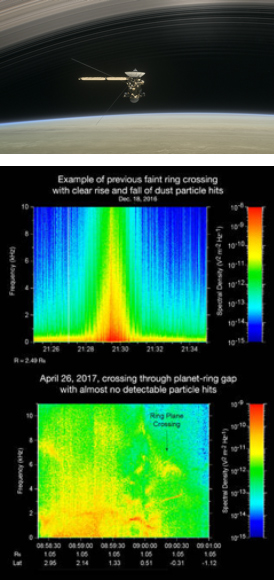
The data collected during NASA’s Cassini spacecraft’s Grand Finale pleasantly surprised the Cassini team. On April 26th, Cassini dove through the narrow gap between Saturn and its rings for the second time and discovered, surprisingly, that the area is much less dusty than the Cassini team anticipated. Based on previous images taken by Cassini, models made of the ring particle environment indicated that the spacecraft would be at risk for damage from large particles. To prepare for such risks, the Cassini team planned to use the spacecraft’s saucer-shaped main antenna as a shield of sorts to protect its main instruments. However, this plan would change how and when the instruments would be able to make observations.
Luckily, Cassini instruments discovered that no such precautions were necessary because the region it was traveling was relatively dust-free. In fact, Cassini’s Radio and Plasma Wave Science (RPWS) instrument surprisingly only detected a few taps from small particles when the spacecraft traveled through the gap on April 26th, compared to hundreds of ring particles per second when it crossed outside of Saturn’s main rings.
The low amount of ring particles detected both delighted and puzzled the Cassini team. The spacecraft was able to move forward with its preferred usage of its instruments to obtain scientific observations of Saturn and its rings. Stay tuned for more information on Cassini as it travels through Saturn’s rings during its Grand Finale! #GetExcitedSU
Explore more: Watch the video above to listen and count the particle hits as Cassini crosses through the planet-ring gap!

